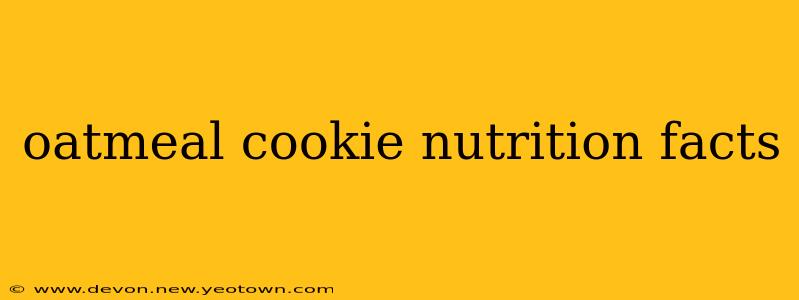Let's be honest, the irresistible aroma of freshly baked oatmeal cookies is enough to make anyone's mouth water. But beyond the delightful taste and comforting texture, what's really in those chewy delights? Understanding the nutritional facts of oatmeal cookies can help you enjoy them mindfully as part of a balanced diet. This isn't about depriving yourself; it's about making informed choices!
This journey into the world of oatmeal cookie nutrition will go beyond simple calorie counts. We'll explore the varying nutritional profiles based on ingredients, portion sizes, and even homemade versus store-bought versions. Get ready to unravel the secrets hidden within these beloved treats!
What are the calories in an oatmeal cookie?
The calorie count of an oatmeal cookie varies wildly depending on its size and ingredients. A small, average oatmeal cookie (roughly 1 ounce or 28 grams) might contain anywhere from 100 to 150 calories. However, larger cookies, those packed with extra butter, sugar, or chocolate chips, can easily exceed 200 calories per cookie. Remember, those seemingly innocent additions quickly add up!
How much sugar is in an oatmeal cookie?
Sugar is a major player in the oatmeal cookie's deliciousness, but it's also a significant contributor to its calorie count. A single cookie can contain anywhere from 5 to 15 grams of sugar, depending on the recipe. This is largely due to the added sugars like granulated sugar, brown sugar, and even the sugars naturally present in ingredients like dried fruits or chocolate chips. Choosing recipes that incorporate less refined sugar or utilizing natural sweeteners like maple syrup in moderation can help you manage your sugar intake.
What are the carbs in an oatmeal cookie?
Oatmeal cookies are naturally high in carbohydrates, primarily from the oats themselves. A typical cookie might contain 15 to 25 grams of carbohydrates. This includes both simple sugars (as discussed above) and complex carbohydrates from the oats which provide sustained energy. However, be mindful of the overall carbohydrate content, especially if you're managing your blood sugar levels.
How much fat is in an oatmeal cookie?
The fat content in oatmeal cookies largely comes from the butter, oil, and other fats used in the recipe. This can significantly impact the overall calorie count and nutritional profile. A typical cookie might contain anywhere from 5 to 10 grams of fat. Choosing recipes with less butter or substituting with healthier fats like olive oil can be a way to tweak the nutritional content for the better.
Are oatmeal cookies healthy?
The "healthy" aspect of oatmeal cookies is a complex question. While oats themselves are a good source of fiber and provide some beneficial nutrients, the added sugars, fats, and other ingredients in most recipes can negate these benefits. It all comes down to moderation and ingredient choices. Homemade oatmeal cookies, where you control the ingredients, offer greater potential for healthier options compared to store-bought varieties which often contain added preservatives and trans fats.
What are the benefits of eating oatmeal cookies (in moderation)?
Let's not forget the positive side! In moderation, oatmeal cookies can offer some perks:
- Fiber: Oats are a good source of fiber, which aids digestion and can help you feel full for longer.
- Energy boost: The carbohydrates in oatmeal cookies can provide a quick energy boost, especially beneficial before a workout.
- Comfort food: There's something undeniably comforting about a warm, delicious oatmeal cookie. Enjoying them mindfully as an occasional treat can improve mood and overall well-being.
How can I make healthier oatmeal cookies?
Making healthier oatmeal cookies is entirely possible! Here are a few tips:
- Reduce sugar: Use less sugar than called for in your recipe or explore healthier alternatives.
- Increase oats: Adding more oats can increase the fiber content while slightly reducing the overall amount of other ingredients.
- Add healthy ingredients: Incorporating nuts, seeds, or dried fruits can add nutrients and flavor while potentially decreasing the need for added sugars.
- Use whole wheat flour: Partially substituting whole wheat flour for all-purpose flour can increase fiber content.
In conclusion, the nutritional facts of oatmeal cookies are dynamic and depend largely on their ingredients and size. While not a health food per se, indulging in these treats occasionally, while being mindful of portion sizes and making smarter ingredient choices, allows you to savour the deliciousness without excessive guilt. Enjoy responsibly!

